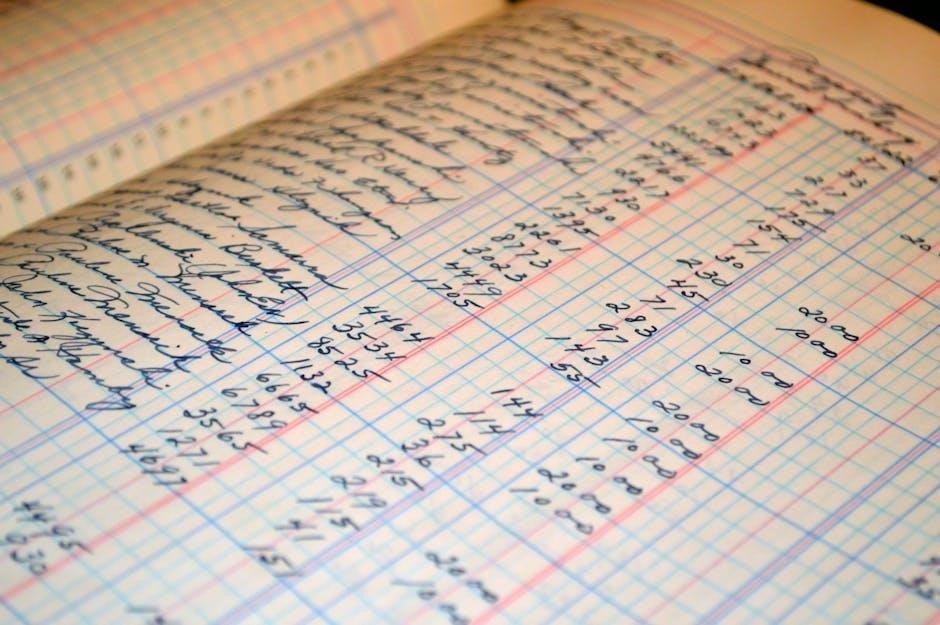centigrade to fahrenheit chart pdf
A Centigrade to Fahrenheit chart is a valuable tool for converting temperatures between the two scales․ It offers a quick reference guide for everyday temperature conversions․
Perfect for cooking, scientific tasks, and weather monitoring, this chart provides accurate and easy-to-read temperature mappings in a convenient PDF format for easy sharing and printing․
Overview of Temperature Conversion
Temperature conversion is a fundamental process that enables the translation of values between different scales, primarily Celsius and Fahrenheit․ This process is essential in various fields, including cooking, scientific research, and weather forecasting․ Understanding how to convert temperatures accurately ensures consistency and clarity in measurements․ The Celsius and Fahrenheit scales are widely used globally, with Celsius being part of the metric system and Fahrenheit commonly used in the United States․ Converting between these scales requires a clear understanding of their relationship and the formulas involved․ Accurate temperature conversion is crucial for ensuring precise results in both everyday applications and complex scientific calculations․
Importance of Using Conversion Charts
Using a Centigrade to Fahrenheit conversion chart is essential for ensuring accuracy and consistency in temperature measurements․ These charts provide a quick and reliable way to translate values between the two scales, eliminating the risk of calculation errors․ They are particularly useful for individuals who need to work with both Celsius and Fahrenheit, such as chefs, scientists, and weather forecasters․ Conversion charts are also valuable for educational purposes, helping students and professionals alike to understand the relationship between the scales․ Additionally, they save time by offering pre-calculated values, making them an indispensable tool in both everyday and specialized applications․
Benefits of PDF Format for Conversion Charts
The PDF format offers numerous advantages for Centigrade to Fahrenheit conversion charts․ It ensures that the document is portable and maintains consistent formatting across all devices․ PDFs are easy to share, print, and access offline, making them ideal for quick reference․ They also support high-quality visuals, ensuring that charts and tables remain clear and readable․ Additionally, PDFs are secure and cannot be easily altered, preserving the accuracy of the conversion data․ This format is particularly useful for creating printable charts that can be distributed widely without losing their professional appearance or functionality․ Overall, PDFs provide a reliable and user-friendly solution for temperature conversion needs․

Understanding the Centigrade and Fahrenheit Scales
The Centigrade (Celsius) and Fahrenheit scales measure temperature, with Celsius used scientifically and Fahrenheit in the US․ Celsius sets water’s freezing point at 0°C and boiling at 100°C, while Fahrenheit uses 32°F and 212°F for these points, reflecting different zero points and scaling․
History of the Celsius Scale
The Celsius scale was created by Swedish astronomer Anders Celsius in 1742․ Initially, he reversed the scale, setting water’s freezing point at 100° and boiling at 0°․ After his death, the scale was inverted by other scientists to the version we use today, with water freezing at 0°C and boiling at 100°C․ This change made the scale more intuitive for scientific use․ The Celsius scale became a cornerstone of the metric system, widely adopted globally for its logical and consistent intervals․ Its creation revolutionized temperature measurement, providing a standardized tool for scientific and everyday applications․
History of the Fahrenheit Scale
The Fahrenheit scale was developed by German physicist Gabriel Fahrenheit in 1724․ He created it using a mixture of ice, water, and ammonium chloride to establish a consistent temperature scale․ Initially, the scale set the freezing point of water at 32°F and the boiling point at 212°F, creating 180 degrees between these two points․ This scale was widely adopted in English-speaking countries, particularly in the United States, for everyday applications like weather forecasting and cooking․ Over time, despite the metric system’s global adoption, the Fahrenheit scale remains popular, especially in the U․S․, due to its historical use and practical applications in specific fields․
Key Differences Between the Two Scales
The Celsius and Fahrenheit scales differ fundamentally in their reference points and interval sizes․ Celsius defines the freezing point of water at 0°C and boiling at 100°C, while Fahrenheit sets these at 32°F and 212°F, respectively․ Each degree in Celsius is larger than a Fahrenheit degree, with 1°C equal to 1;8°F․ This makes Celsius intervals more straightforward for scientific calculations․ Additionally, Celsius is widely adopted in most countries for scientific and everyday use, whereas Fahrenheit remains prevalent in the United States for weather and cooking․ These differences highlight the need for clear conversion tools, like charts, to ensure accuracy across applications․

The Conversion Process

The conversion process involves using formulas to switch between Celsius and Fahrenheit․ For Celsius to Fahrenheit, the formula is °F = (°C × 9/5) + 32․ The reverse converts Fahrenheit to Celsius using °C = (°F ー 32) × 5/9․ These formulas enable precise temperature transformations, essential for various applications like cooking, engineering, and weather forecasting․ Utilizing a PDF chart simplifies this process, providing a visual and quick reference guide for common temperature conversions, ensuring accuracy and efficiency in daily tasks and professional settings․
Formulas for Conversion
The formulas for converting temperatures between Celsius and Fahrenheit are essential tools․ To convert Celsius to Fahrenheit, use the formula: °F = (°C × 9/5) + 32․ For example, 0°C equals 32°F․ To convert Fahrenheit to Celsius, the formula is: °C = (°F ー 32) × 5/9․ These mathematical equations provide precise temperature conversions․ Understanding these formulas is crucial for accurate conversions, especially in scientific, culinary, and engineering applications․ A Centigrade to Fahrenheit chart PDF often includes these formulas for quick reference․ By mastering these equations, users can easily switch between the two scales, ensuring accuracy in their work or daily tasks․ These formulas are the foundation of temperature conversion․
Step-by-Step Guide to Convert Celsius to Fahrenheit
Converting Celsius to Fahrenheit is straightforward with a simple step-by-step approach․ Start by identifying the temperature in Celsius․ Next, multiply this value by 9/5 to adjust the scale․ Finally, add 32 to the result to account for the difference in zero points․ For example, to convert 20°C:
Multiply 20 by 9/5, resulting in 36․
Add 32 to 36, yielding 68°F․
This method ensures accurate conversions․ Using a Centigrade to Fahrenheit chart PDF can streamline this process, providing pre-calculated values for quick reference․ This guide is perfect for both beginners and professionals needing precise temperature conversions․ By following these steps, anyone can easily convert Celsius to Fahrenheit with confidence․
Examples of Conversions
Here are some practical examples to illustrate the Celsius to Fahrenheit conversion process:
– 0°C (freezing point of water) converts to 32°F using the formula: F = (9/5)×0 + 32 = 32°F․
– 20°C (room temperature) converts to 68°F: F = (9/5)×20 + 32 = 68°F․
– 37°C (average human body temperature) converts to 98․6°F: F = (9/5)×37 + 32 = 98․6°F․
– 100°C (boiling point of water) converts to 212°F: F = (9/5)×100 + 32 = 212°F․
These examples demonstrate how the formula works in real-world scenarios, making it easier to understand and apply․ A Centigrade to Fahrenheit chart PDF can provide a quick reference for such conversions, saving time and effort in various applications․

Designing a Centigrade to Fahrenheit Chart
Creating a clear and user-friendly chart involves organizing temperature ranges in a table format․ Ensure readability with proper formatting and visual cues for easy understanding and quick reference․
Elements of an Effective Conversion Chart
An effective temperature conversion chart should include clear headings, consistent scales, and a balanced range of temperatures․ Use bold labels for Celsius and Fahrenheit columns to enhance readability․
Organize the data in ascending order, with regular intervals between temperature points for easy lookup․ Incorporate visual separators between rows to prevent clutter and improve scanning efficiency․
Consider adding a key or formula section to explain the conversion process․ This ensures users understand the relationship between the scales, making the chart both a reference and a learning tool․
Ensure compatibility by saving the chart in a widely accessible format, such as PDF, to accommodate different devices and printing needs without loss of quality or formatting․
Best Practices for Readability and Usability
Ensure the chart has a clean, uncluttered layout with clear visual hierarchy․ Use sans-serif fonts for better readability on screens and prints․ Maintain consistent spacing between rows to avoid overcrowding․
Highlight key elements like temperature intervals or conversions with subtle color coding․ Include a formula section in italics for quick reference, such as C = (F ⎯ 32) × 5/9․
Add a small legend or example at the top to guide users, e․g․, Example: 32°F = 0°C․ Use bold headers for Celsius and Fahrenheit labels to enhance navigation․
Ensure the PDF is scalable for various devices and printing sizes․ Test the chart for clarity under different zoom levels and screen resolutions to guarantee usability․
Keep the design professional yet simple, avoiding unnecessary graphics or distractions that could hinder quick data retrieval․
How to Create a Printable PDF Chart
Start by creating a table in a spreadsheet program like Excel or Google Sheets․ Set up two columns for Celsius and Fahrenheit temperatures, ensuring the range covers common values (e․g․, -20°C to 100°C)․
Use the conversion formula C = (F ー 32) × 5/9 or F = (C × 9/5) + 32 to populate the data accurately․ Add a header row with bold text for clarity․
Export the sheet as a PDF, ensuring the layout fits standard paper sizes like A4 or Letter․ Include a title and date at the top for reference․
Test the PDF by printing it to ensure readability and proper scaling․ Adjust fonts or spacing if necessary for better clarity․

Practical Applications of the Conversion Chart
The chart simplifies temperature conversions for cooking, scientific experiments, and weather forecasting․ It’s ideal for recipe adjustments, lab measurements, and precise weather reporting in both scales․
Use in Cooking and Recipes
Cooking often requires precise temperature control, making a Centigrade to Fahrenheit chart indispensable․ Whether converting oven temperatures for baking or ensuring meats roast at the correct heat, the chart simplifies recipe adjustments․
For instance, 180°C for baking converts to 350°F, while 75°C for medium-rare steak becomes 167°F․ This tool is especially useful for recipes originating from different regions, ensuring dishes turn out perfectly regardless of the scale used․
A printable PDF chart is ideal for kitchen use, providing quick reference and eliminating the need for manual calculations during cooking․

Use in Scientific and Engineering Applications
In scientific and engineering fields, precise temperature conversion is crucial․ A Centigrade to Fahrenheit chart is essential for researchers and engineers working with data in both scales․
For example, in experiments requiring exact temperature controls, converting -20°C to -4°F ensures accuracy․ The chart is also vital in industries like materials science and thermodynamics, where temperature differences significantly impact results․
Having a PDF chart readily available streamlines workflows, reducing errors and saving time in high-stakes applications․
Use in Weather Forecasting and Reporting
Temperature conversion charts are indispensable in meteorology for accurately reporting weather conditions․ Meteorologists often need to present data in both Celsius and Fahrenheit, especially for international audiences․
A Centigrade to Fahrenheit chart ensures precise conversions, critical for severe weather alerts․ For instance, converting -10°C to 14°F or 35°C to 95°F quickly and accurately is vital for public safety and understanding․
PDF charts are ideal for weather stations, as they provide a quick, printable reference․ This tool enhances efficiency, allowing meteorologists to focus on analysis and timely reporting during critical weather events․

Top Resources for Centigrade to Fahrenheit Charts

Discover reliable websites offering downloadable PDF charts, software tools for customization, and DIY templates to create precise temperature conversion guides tailored to your needs․
Recommended Websites for Downloadable PDFs
Several websites provide high-quality, downloadable PDF charts for converting temperatures between Celsius and Fahrenheit․ Conversion-Chart․com offers a variety of formats, including detailed tables and printable graphs․ TemperatureConvert․net provides customizable charts, allowing users to specify temperature ranges․ PDFConverterPro․com specializes in professional-grade PDFs with precise conversions, ideal for technical applications․ These websites ensure accuracy, ease of use, and accessibility, making them top choices for anyone needing reliable temperature conversion tools․ They are frequently updated and trusted by professionals and enthusiasts alike for their clarity and precision․
Software Tools for Creating Custom Charts
Excel, Google Sheets, and LibreOffice Calc are excellent tools for creating custom Centigrade to Fahrenheit charts․ Users can input temperature ranges, apply formulas for conversions, and design visually appealing tables or graphs․ For more advanced designs, Adobe Illustrator or Canva can be used to create professional-looking charts․ Python libraries like Matplotlib and Seaborn are ideal for technical users, offering programmable solutions to generate precise, customizable charts․ These tools allow users to tailor charts to specific needs, ensuring clarity and accuracy․ Whether for personal use or professional applications, these software options provide flexibility and efficiency in creating temperature conversion charts․
Templates for DIY Conversion Charts
DIY enthusiasts can utilize pre-designed templates to create Centigrade to Fahrenheit charts․ Websites like Template․net and Vertex42 offer free, downloadable templates in PDF and Excel formats․ These templates include customizable tables, formulas, and visually appealing layouts․ Users can input temperature ranges, apply conversion formulas, and print the charts for easy reference․ Additionally, platforms like Canva provide design templates for creating visually stunning charts․ These resources save time and effort, allowing users to focus on customization rather than building charts from scratch․ Whether for personal, educational, or professional use, these templates are a practical solution for creating accurate and user-friendly conversion charts․

Troubleshooting Common Conversion Errors
Identifying and Avoiding Mistakes
Common errors include incorrect formula usage and decimal inaccuracies․ Always verify the conversion formula and ensure precise calculations․ For example, 0°C equals 32°F, not 33°F․
Common errors in temperature conversion often stem from incorrect formula usage or rounding inaccuracies․ Ensure the formula ( F = rac{9}{5}C + 32 ) is applied accurately․ Misplacing decimals or miscalculating can lead to significant errors, especially in precise applications like cooking or science․ For example, 100°C should always convert to 212°F, not 180°F․ Regularly cross-check conversions using a reliable chart or calculator to maintain accuracy․ Pay attention to negative temperatures as well, as mistakes here are frequent․ Proper training and practice can help minimize these issues, ensuring reliable and consistent temperature conversions in both personal and professional settings․
Calibration and Accuracy Tips
Ensuring the accuracy of your Centigrade to Fahrenheit chart involves regular calibration․ Start by verifying key temperature points, such as the boiling and freezing points of water (100°C/212°F and 0°C/32°F)․ Cross-check these values with a reliable thermometer to confirm precision․ For digital tools, update software or firmware periodically to maintain correctness․ When creating a PDF chart, use high-resolution fonts and clear formatting to enhance readability․ Avoid manual data entry errors by using automated conversion tools or scripts․ Lastly, test the chart with known temperature pairs to ensure consistency and reliability across the entire range of conversions․
The Centigrade to Fahrenheit chart remains essential for precise temperature conversions, with digital tools and AI enhancing its accessibility and integration into modern applications and technologies․
The Evolution of Temperature Conversion Tools
Temperature conversion tools have evolved significantly, from manual charts to digital solutions․ Early methods relied on printed tables, while modern tools leverage AI and machine learning for real-time conversions․ The rise of smartphones and apps has made temperature conversion more accessible, with instant results and customizable options․ PDF charts remain popular for their simplicity and offline accessibility, complementing advanced digital tools․ As technology advances, integration with smart devices and voice assistants is expected, further streamlining temperature conversion processes․ These innovations ensure that users can convert temperatures efficiently, whether in professional or everyday settings, using the method that best suits their needs and preferences․
Integration with Modern Technology
The integration of temperature conversion tools with modern technology has revolutionized how we handle temperature data․ Smartphone apps and voice assistants now offer instant conversions, while IoT devices enable real-time monitoring․ Cloud-based platforms allow seamless data synchronization across devices, ensuring accessibility anywhere․ AI-driven features enhance accuracy and provide personalized conversion experiences․ Modern tools also support multiple formats, including PDF charts, making them versatile for both digital and offline use․ These advancements streamline processes in industries like cooking, engineering, and weather forecasting, ensuring efficiency and precision․ As technology continues to evolve, temperature conversion tools will become even more sophisticated, offering tailored solutions to meet diverse user needs․

